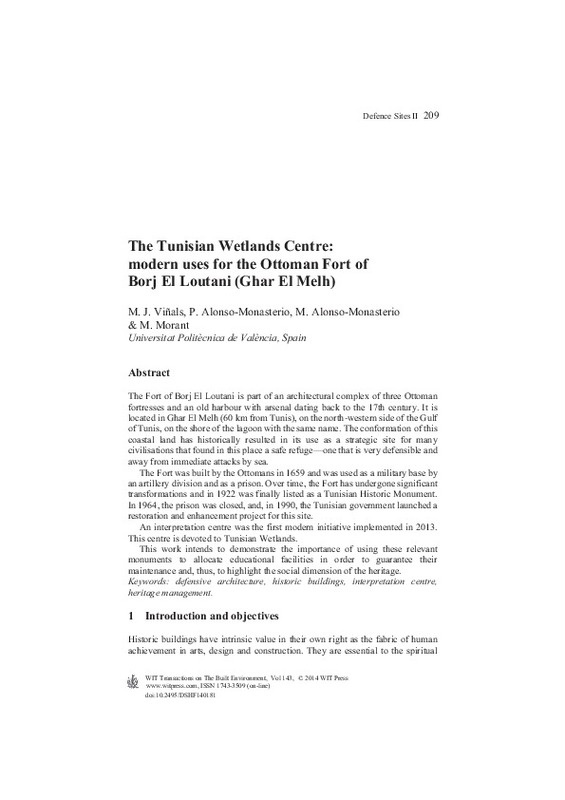JavaScript is disabled for your browser. Some features of this site may not work without it.
Buscar en RiuNet
Listar
Mi cuenta
Estadísticas
Ayuda RiuNet
Admin. UPV
The Tunisian Westlands Centre: modern uses for the Ottoman Fort of Borj El Loutani (Ghar El Melh)
Mostrar el registro sencillo del ítem
Ficheros en el ítem
| dc.contributor.author | Viñals Blasco, Mª José
|
es_ES |
| dc.contributor.author | Alonso-Monasterio Fernández, Pau
|
es_ES |
| dc.contributor.author | Alonso Monasterio Fernández, Mireia Llibertat
|
es_ES |
| dc.contributor.author | Morant González, Maryland
|
es_ES |
| dc.date.accessioned | 2015-11-19T18:00:36Z | |
| dc.date.available | 2015-11-19T18:00:36Z | |
| dc.date.issued | 2014 | |
| dc.identifier.issn | 1746-4498 | |
| dc.identifier.uri | http://hdl.handle.net/10251/57785 | |
| dc.description.abstract | The Fort of Borj El Loutani is part of an architectural complex of three Ottoman fortresses and an old harbour with arsenal dating back to the 17th century. It is located in Ghar El Melh (60 km from Tunis), on the north-western side of the Gulf of Tunis, on the shore of the lagoon with the same name. The conformation of this coastal land has historically resulted in its use as a strategic site for many civilisations that found in this place a safe refuge—one that is very defensible and away from immediate attacks by sea. The Fort was built by the Ottomans in 1659 and was used as a military base by an artillery division and as a prison. Over time, the Fort has undergone significant transformations and in 1922 was finally listed as a Tunisian Historic Monument. In 1964, the prison was closed, and, in 1990, the Tunisian government launched a restoration and enhancement project for this site. An interpretation centre was the first modern initiative implemented in 2013. This centre is devoted to Tunisian Wetlands. This work intends to demonstrate the importance of using these relevant monuments to allocate educational facilities in order to guarantee their maintenance and, thus, to highlight the social dimension of the heritage. | es_ES |
| dc.language | Inglés | es_ES |
| dc.publisher | WIT Press | es_ES |
| dc.relation.ispartof | WIT Transactions on the Built Environment | es_ES |
| dc.rights | Reserva de todos los derechos | es_ES |
| dc.subject | Defensive architecture | es_ES |
| dc.subject | Historic buildings | es_ES |
| dc.subject | Interpretation centres | es_ES |
| dc.subject | Heritage management | es_ES |
| dc.subject.classification | INGENIERIA CARTOGRAFICA, GEODESIA Y FOTOGRAMETRIA | es_ES |
| dc.subject.classification | GEOGRAFIA FISICA | es_ES |
| dc.title | The Tunisian Westlands Centre: modern uses for the Ottoman Fort of Borj El Loutani (Ghar El Melh) | es_ES |
| dc.type | Artículo | es_ES |
| dc.identifier.doi | 10.2495/DSHF140181 | |
| dc.rights.accessRights | Abierto | es_ES |
| dc.contributor.affiliation | Universitat Politècnica de València. Departamento de Ingeniería Cartográfica Geodesia y Fotogrametría - Departament d'Enginyeria Cartogràfica, Geodèsia i Fotogrametria | es_ES |
| dc.contributor.affiliation | Universitat Politècnica de València. Departamento de Proyectos de Ingeniería - Departament de Projectes d'Enginyeria | es_ES |
| dc.description.bibliographicCitation | Viñals Blasco, MJ.; Alonso-Monasterio Fernandez, P.; Alonso Monasterio Fernandez, ML.; Morant González, M. (2014). The Tunisian Westlands Centre: modern uses for the Ottoman Fort of Borj El Loutani (Ghar El Melh). WIT Transactions on the Built Environment. 143:209-220. doi:10.2495/DSHF140181 | es_ES |
| dc.description.accrualMethod | S | es_ES |
| dc.relation.publisherversion | http://dx.doi.org/10.2495/DSHF140181 | es_ES |
| dc.description.upvformatpinicio | 209 | es_ES |
| dc.description.upvformatpfin | 220 | es_ES |
| dc.type.version | info:eu-repo/semantics/publishedVersion | es_ES |
| dc.description.volume | 143 | es_ES |
| dc.relation.senia | 283536 | es_ES |
| dc.identifier.eissn | 1743-3509 |








